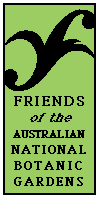Eucalyptus
nova-anglica in the Australian
National Botanic Gardens is in Section 4, downhill from the sundial
in the Rock Garden. There are two large specimens. This species, New
England Peppermint, is also called Black Peppermint. It has a finely
fibrous bark.

E.nova-anglica
Photo : Murray Fagg
Its natural distribution
is in the New England tablelands of New South Wales (hence the specific
name of nova-anglica), extending into the adjacent high country
of south-eastern Queensland. Its altitudinal range is 500 to 1500 metres,
mainly above 750 metres. The climate is cool to cold, with frequent
frosts and snow in winter, and a rainfall of about 1000mm. In colder
sites it grows with the Snow Gum (E. pauciflora subspecies pauciflora),
Black Sally (E. stellulata) and Candlebark (E. rubida),
but on drier and slightly warmer sites it occurs with New England Blackbutt
(E. andrewsii subspecies andrewsii) and various stringybarks.
In the past few
decades the growth of E. nova-anglica on the New England tablelands
has been adversely affected by 'rural decline' associated with heavy
grazing by insects, particularly beetles such as chrysomelids and scarabs.
E. nova-anglica
was named by Henry Deane and Joseph Maiden.
Henry Deane (1847-1924),
engineer and scientist, was born in London and educated as an engineer
in Ireland. Soon after graduation he worked on the construction of Hungarian
railways. He came to Sydney in 1880 and became a railway surveyor and
worked on the construction of the railway from Homebush to Hawkesbury
River. Later he worked as a consultant engineer in private practice
for the Commonwealth Oil Corporation Ltd, and constructed a railway
to a shale-oil mine in the Newnes district. In 1908 he was appointed
consulting engineer for the survey of the transcontinental railway between
Port Augusta and Kalgoorlie, and in 1912 he became engineer-in-chief
for the construction branch of the new Commonwealth Railways.
Deane was also
an accomplished botanist and worked on the Tertiary fossil flora of
eastern Australia. He published many papers, often with J.H. Maiden,
on botany and palaeontology and made a special study of Australian timbers.
E. deanei which occurs in the Blue Mountains, is named after
him.
Joseph Henry Maiden
(1859-1925), botanist and public servant, was born in London, completing
a science degree at the University of London. He came to Sydney in 1880
and became curator of the new Technological Museum there. He became
an expert in economic botany and encouraged research into the properties
of Australian timbers and essential oils. In the late 1880's he published
The Useful Native Plants of Australia and Wattles and Wattle-barks.
He became superintendent of technical education in 1894 and in 1896
director of the Botanic Gardens, Sydney, and Government Botanist. One
of his major achievements was the formation of the National Herbarium
of New South Wales, opened in 1901. In 1902 he visited Europe and returned
with nearly 600 botanical specimens collected by Joseph Banks in 1770
and hitherto stored in the British Museum.
Maiden's major
works were A Critical Revision of the Genus Eucalyptus, appearing
in over 70 parts from 1903, in which he recognised 366 species, and
his Forest Flora of New South Wales in 77 parts from 1904. He
published a life of Joseph Banks in 1909, and helped to found Wattle
Day.
In March 2004 a
grove of E. nova-anglica near Armidale on the New England tablelands
was incorporated into a memorial to poet Judith Wright by a local community
group. She was born there in 1915. Her words "Country that built
my heart" are carved on one of the trees in the memorial. She wrote
evocatively of the New England area in her poem South of my days
:
"part
of my blood's country,
rises that tableland, high delicate outline
of bony slopes wincing under the winter,
low trees blue-leaved and olive, outcropping granite
clean, lean, hungry country."
*
* * * *


